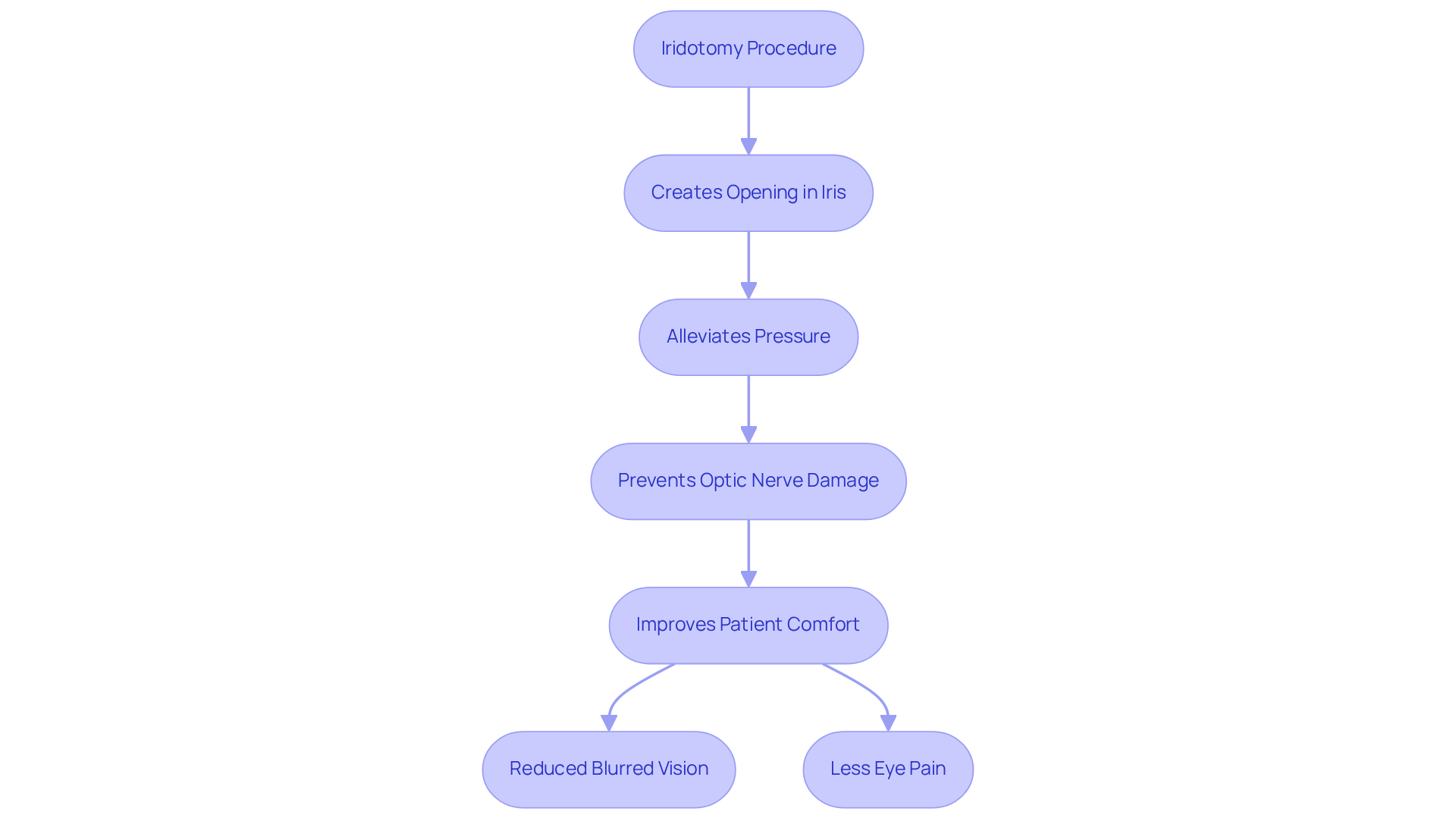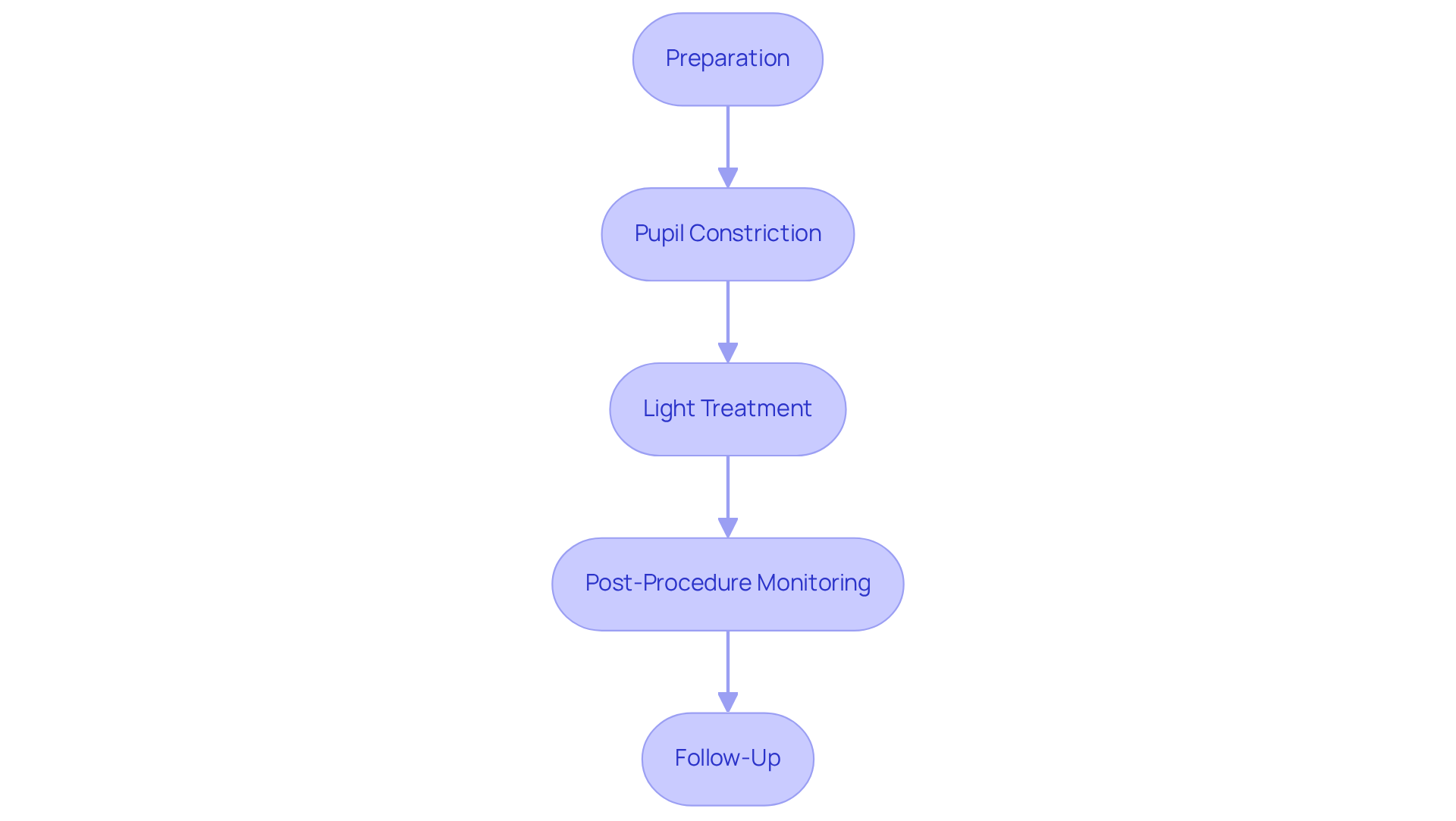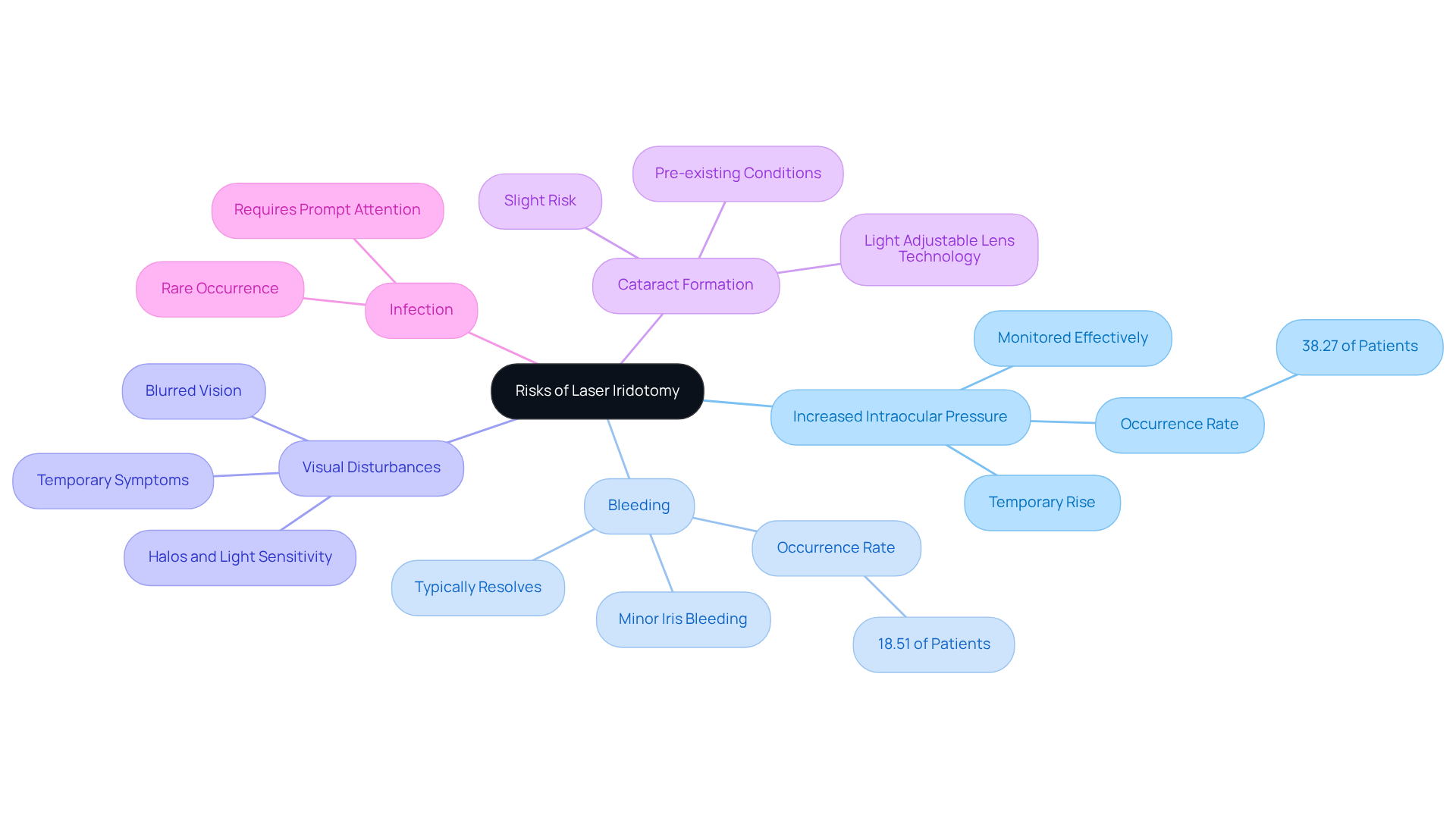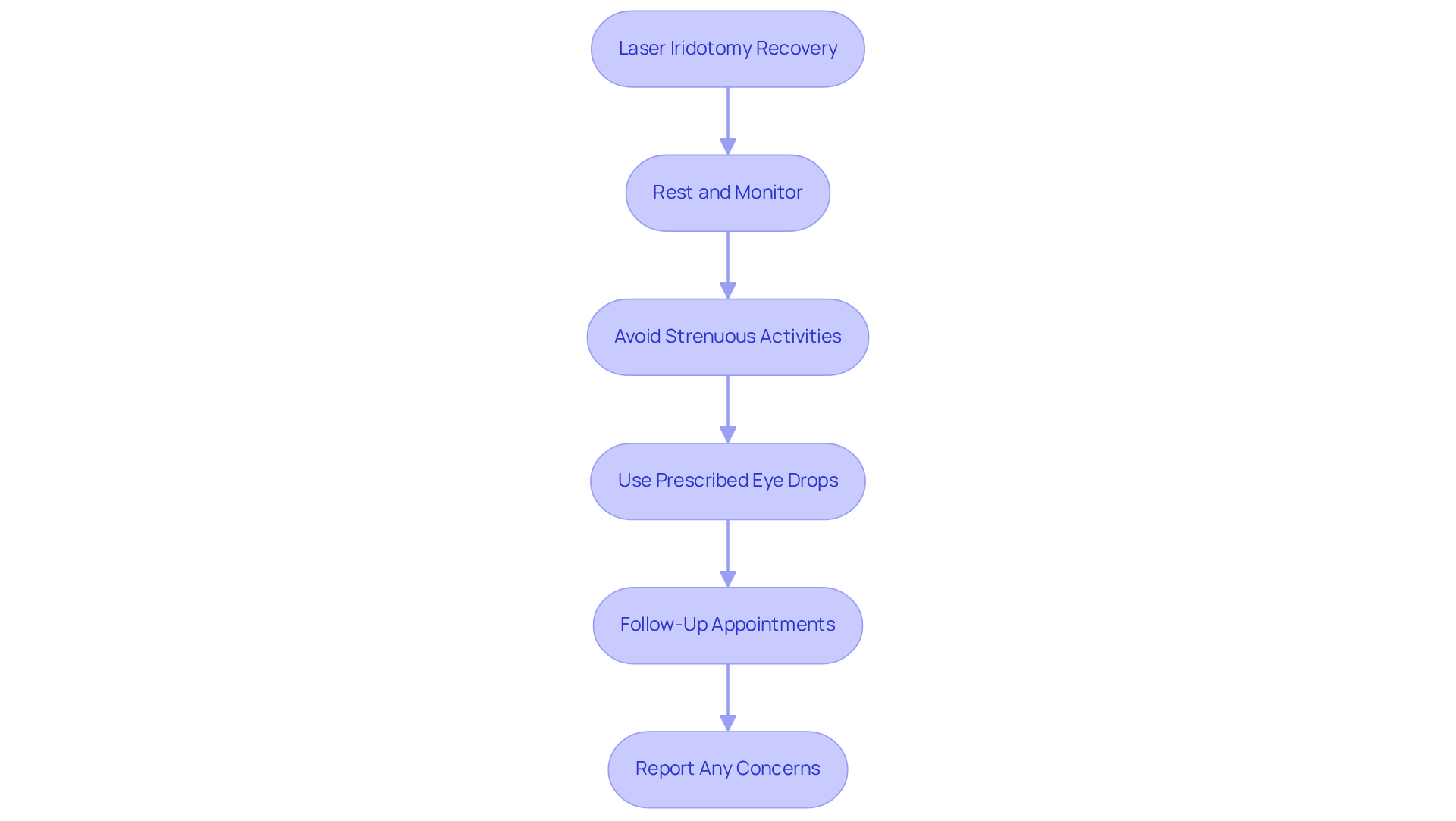Posted by: Northwest Eye in General on August 22, 2025
Overview
Iridotomy is a vital surgical procedure that creates a small opening in the iris. This procedure is designed to treat and prevent angle-closure glaucoma, which can lead to increased intraocular pressure and potential damage to the optic nerve. We understand that learning about such procedures can be daunting, but it’s important to know that iridotomy plays a significant role in protecting your vision and eye health.
The effectiveness and safety of iridotomy have been well-documented, with many patients reporting positive outcomes. It’s common to feel anxious about surgery, but rest assured, this procedure has helped countless individuals maintain their long-term vision. By reducing intraocular pressure, iridotomy not only protects the optic nerve but also contributes to overall eye health.
We are here to help you through this process, and we encourage you to reach out with any questions or concerns. Remember, you are not alone on this journey. Your health and well-being are our top priorities, and we are committed to supporting you every step of the way.
Introduction
Navigating the intricate world of eye health can often unveil hidden dangers, especially regarding conditions like angle-closure glaucoma. We understand that this serious ailment can lead to irreversible vision loss if not addressed promptly. That’s why it’s crucial to grasp effective interventions, such as iridotomy, particularly for those at risk. In this article, we will explore the iridotomy procedure, illuminating its significance, the steps involved, potential risks, and essential aftercare. Our goal is to guide you toward a deeper understanding of how this surgical technique can safeguard your vision.
It’s common to feel overwhelmed with the various options available, and you might wonder: what makes iridotomy the go-to solution for preventing vision loss in glaucoma patients? We are here to help you through this process, ensuring you feel informed and supported every step of the way.
Define Iridotomy and Its Importance in Eye Health
A surgical technique known as iridotomy creates a small opening in the iris, which is the colored part of the eye. This procedure, known as iridotomy, is primarily designed to treat and prevent [angle-closure glaucoma](https://aao.org/eye-health/diseases/what-is-glaucoma), a condition that can be concerning as it occurs when the iris obstructs the drainage angle, leading to [increased intraocular pressure](https://nweyeclinic.com/?p=6404) (IOP). This heightened pressure can potentially damage the optic nerve, which is vital for vision. Iridotomy alleviates pressure and helps mitigate the risk of optic nerve damage by establishing an alternative pathway for aqueous humor—the fluid within the eye.
We understand that navigating the complexities of angle-closure glaucoma can be daunting. Recent updates in treatment highlight the effectiveness of iridotomy, specifically laser peripheral iridotomy (LPI), in preventing acute attacks. Studies indicate that LPI can significantly reduce the incidence of these attacks, with effectiveness comparable to surgical iridotomy. It’s comforting to know that the process is generally safe, with serious complications being rare. Most individuals endure the procedure well and can resume regular activities soon after, which underscores its importance in maintaining long-term vision and eye health.
Real-world examples illustrate the positive impact of an iridotomy procedure on patients’ eye health. For instance, individuals who underwent LPI reported improved comfort and reduced symptoms associated with angle-closure glaucoma, such as blurred vision and eye pain. The process not only alleviates immediate pressure but also contributes to long-term eye health by preventing further complications.
The prevalence of angle-closure glaucoma is significant, affecting millions of individuals, particularly those over 60. With more than 3 million Americans affected by glaucoma and another 200,000 identified annually, comprehending the significance of interventions such as iridotomy is essential. As one expert noted, ‘LPI should only be offered to those with the (very) highest risk of PACG,’ emphasizing the need for careful patient selection and timely intervention.
In summary, managing angle-closure glaucoma involves the vital role of iridotomy, which offers key benefits for long-term vision and eye health. We encourage regular eye exams and for individuals at risk, ensuring they receive the appropriate treatment to maintain their vision. We are here to help you through this process, providing the support and care you need.

Explain the Laser Iridotomy Procedure: Steps and Techniques
The technique of iridotomy is a minimally invasive method designed to reduce intraocular pressure and prevent angle-closure glaucoma. We understand that you may have concerns about your eye health, and we are here to guide you through this process. Here’s what you can expect during the procedure:
- Preparation: You will be comfortably seated, and anesthetic eye drops will be applied to numb your eye. This significantly reduces any discomfort you might feel during the procedure.
- Pupil Constriction: Additional drops will help narrow your pupil, enhancing visibility of the iris and facilitating the beam’s application.
- Light Treatment: A specialized contact lens will be placed on your eye to direct the beam precisely onto the targeted region of the iris. Using a YAG device, the surgeon will make a small incision in the peripheral iris. This procedure typically lasts no more than 10 minutes, usually requiring about 5-10 minutes for each eye.
- Post-Procedure Monitoring: After the light treatment, your eye pressure will be closely monitored to ensure stability, which is crucial for preventing immediate complications. It’s common to experience temporary side effects, such as redness, light sensitivity, and mild headaches in the treated eye, along with blurry vision for a few hours post-procedure; however, these symptoms typically resolve quickly.
- Follow-Up: We encourage you to arrange a follow-up appointment to assess the success of the operation and monitor for any potential complications. Research indicates that around 96% of individuals do not require additional procedures after undergoing an iridotomy, underscoring its effectiveness. However, it’s important to be aware that some individuals may require additional treatments if the closure of the iridotomy occurs.
Improvements in techniques for iridotomy have significantly enhanced outcomes for patients. Many ophthalmologists have observed the procedure’s rapid execution and minimal risks. While complications are rare, being aware of , such as headache, brow pain, and a sudden increase in eye tension, is essential for managing expectations.
Overall, iridotomy is a crucial procedure for individuals at risk of angle-closure glaucoma, offering a dependable way to preserve your eye health. We are here to support you every step of the way.

Discuss Risks and Complications of Laser Iridotomy
While laser iridotomy is generally regarded as a safe procedure, we recognize that some patients may have concerns regarding . Here are a few important points to consider:
- Increased Intraocular Pressure: It’s common to experience a temporary rise in eye pressure immediately after the procedure. Rest assured, this is usually monitored and managed effectively.
- Bleeding: Minor bleeding from the iris may occur, but it typically resolves on its own without intervention.
- Visual Disturbances: Some individuals might notice temporary visual disturbances, such as blurred vision, halos, or light sensitivity. It’s important to understand these symptoms, as blurred vision can sometimes indicate underlying issues like cataracts or diabetic retinopathy, which may require further evaluation and treatment options at Northwest Eye.
- Cataract Formation: There is a slight risk of cataract development following the procedure, especially in patients with pre-existing cataracts. The Light Adjustable Lens (LAL) technology offers a personalized approach to vision correction during cataract surgery, allowing for adjustments post-surgery to enhance visual outcomes.
- Infection: Although rare, there is a risk of infection at the treatment site, which requires prompt medical attention.
We encourage you to discuss the risks associated with the surgery, such as the possibility of requiring an iridotomy, with your ophthalmologist to ensure you have a comprehensive understanding. It’s important to remember that professional eye care plays a crucial role in managing symptoms like glare and halos, which can affect your night driving experience. We are here to help you through this process and support you every step of the way.

Outline Recovery and Aftercare Following Laser Iridotomy
Recovery after laser iridotomy is generally swift, and we recognize the importance of following specific aftercare guidelines for optimal healing.
- Rest and Monitor: We recommend that you take the time to rest for the remainder of the day post-procedure. It’s also essential to closely monitor your vision for any significant changes.
- Avoid Strenuous Activities: It’s common to feel eager to return to your routine, but we advise you to refrain from heavy lifting, strenuous exercise, or any activities that may strain your eyes for at least 24 hours.
- Use Prescribed Eye Drops: Following the prescribed regimen of anti-inflammatory or antibiotic eye drops is crucial. This step helps prevent infection and reduces inflammation, giving you peace of mind during your recovery.
- Follow-Up Appointments: Regular follow-up appointments are vital for monitoring eye pressure and assessing the success of the iridotomy. We suggest scheduling your within 1-7 days after surgery, with subsequent visits arranged as needed.
- Report Any Concerns: If you experience severe pain, significant vision changes, or signs of infection, such as increased redness or discharge, please do not hesitate to reach out to your ophthalmologist immediately.
Patient testimonials often highlight that those who diligently followed these aftercare instructions reported smoother recoveries and fewer complications. Eye care professionals emphasize that adherence to aftercare guidelines significantly enhances recovery outcomes, ensuring long-term eye health. By following these essential aftercare tips, you can facilitate a seamless recovery and safeguard your vision effectively. Remember, we are here to help you through this process.

Conclusion
Iridotomy plays a critical role in eye health, particularly in managing and preventing angle-closure glaucoma. By creating a small opening in the iris, this procedure helps alleviate intraocular pressure, protecting the optic nerve and preserving vision. We understand that the significance of iridotomy cannot be overstated; it serves as a vital intervention for individuals at risk of developing serious complications associated with glaucoma.
Throughout this article, we’ve discussed key insights into the iridotomy procedure, including:
- The steps involved in laser iridotomy
- Potential risks and complications
- Essential aftercare measures
The effectiveness of this minimally invasive technique has been highlighted, along with the importance of timely intervention and regular follow-up to ensure optimal outcomes. Patient testimonials further reinforce the positive impact of adhering to aftercare guidelines for a smooth recovery.
Ultimately, understanding the importance of iridotomy is crucial for anyone at risk of angle-closure glaucoma. It’s common to feel apprehensive about your eye health, but regular eye exams and awareness of the symptoms can lead to early detection and timely treatment, significantly reducing the risk of vision loss. Taking proactive steps in eye health management not only enhances your well-being but also contributes to a broader commitment to preserving vision for future generations. We are here to help you through this process, ensuring you feel supported every step of the way.
Frequently Asked Questions
What is iridotomy?
Iridotomy is a surgical technique that creates a small opening in the iris, the colored part of the eye, primarily to treat and prevent angle-closure glaucoma.
Why is iridotomy important for eye health?
Iridotomy is important because it alleviates increased intraocular pressure (IOP) caused by angle-closure glaucoma, which can potentially damage the optic nerve and impair vision.
How does iridotomy help with angle-closure glaucoma?
Iridotomy establishes an alternative pathway for aqueous humor, the fluid within the eye, which helps reduce pressure and mitigate the risk of optic nerve damage.
What is laser peripheral iridotomy (LPI)?
Laser peripheral iridotomy (LPI) is a specific type of iridotomy that uses laser technology to create an opening in the iris, effectively preventing acute attacks of angle-closure glaucoma.
How effective is LPI in preventing acute attacks?
Studies have shown that LPI can significantly reduce the incidence of acute attacks of angle-closure glaucoma, with effectiveness comparable to surgical iridotomy.
Is the iridotomy procedure safe?
Yes, the iridotomy procedure is generally safe, with serious complications being rare. Most individuals tolerate the procedure well and can resume regular activities shortly after.
What are the benefits of undergoing an iridotomy procedure?
The benefits include improved comfort, reduced symptoms associated with angle-closure glaucoma (such as blurred vision and eye pain), and long-term eye health by preventing further complications.
Who is most affected by angle-closure glaucoma?
Angle-closure glaucoma affects millions of individuals, particularly those over 60 years old, with more than 3 million Americans diagnosed with glaucoma.
What should individuals at risk for angle-closure glaucoma do?
Individuals at risk should have regular eye exams and early detection to ensure they receive appropriate treatment and maintain their vision.
What is the importance of patient selection for LPI?
Patient selection is crucial, as LPI should only be offered to those at the highest risk of primary angle-closure glaucoma (PACG) to ensure timely and effective intervention.






